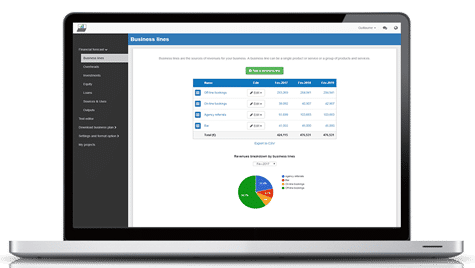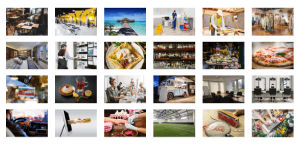How to create a financial forecast for a hunting lodge?
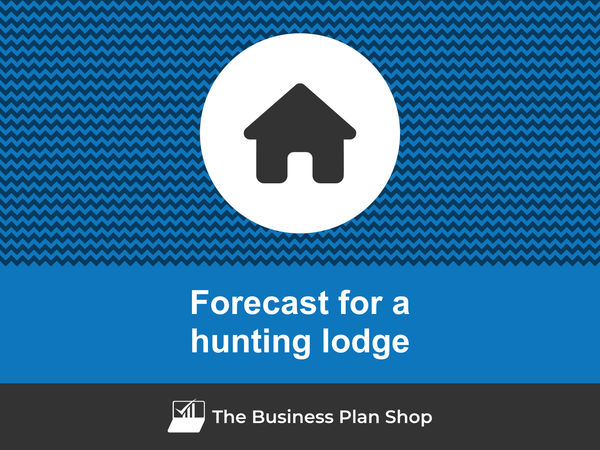
Creating a financial forecast for your hunting lodge, and ensuring it stays up to date, is the only way to maintain visibility on future cash flows.
This might sound complex, but with the right guidance and tools, creating an accurate financial forecast for your hunting lodge is not that hard.
In this guide, we'll cover everything from the main goal of a financial projection, the data you need as input, to the tables that compose it, and the tools that can help you build a forecast efficiently.
Without further ado, let us begin!
Why create and maintain a financial forecast for a hunting lodge?
The financial projections for your hunting lodge act as a financial blueprint to guide its growth with confidence and ensure its long-term financial viability.
To create them, you will need to look at your business in detail - from sales to operating costs and investments - to assess how much profit it can generate in the years to come and what will be the associated cash flows.
During challenging market conditions, maintaining an up-to-date financial forecast enables early detection of potential financial shortfalls, allowing for timely adjustments or securing financing before facing a cash crisis.
Your hunting lodge's financial forecast will also prove invaluable when seeking financing. Banks and investors will undoubtedly request a thorough examination of your financial figures, making precision and presentation essential.
Need a solid financial forecast?
The Business Plan Shop does the maths for you. Simply enter your revenues, costs and investments. Click save and our online tool builds a three-way forecast for you instantly.
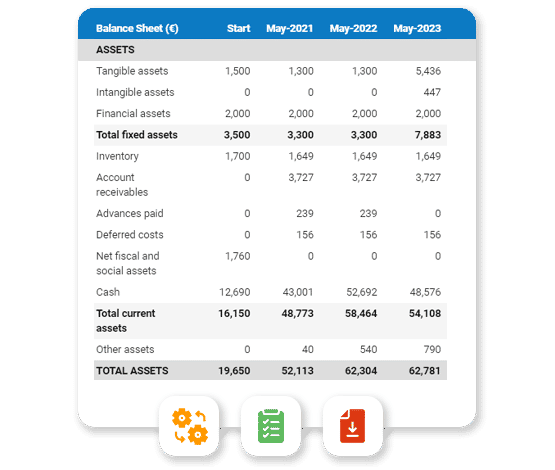
What information is needed to build a hunting lodge financial forecast?
The quality of your inputs is key when it comes to financial modelling: no matter how good the model is, if your inputs are off, so will the forecast.
If you are building a financial plan to start a hunting lodge, you will need to have done your market research and have a clear picture of your sales and marketing strategies so that you can project revenues with confidence.
You will also need to have a clear idea of what resources will be required to operate the hunting lodge on a daily basis, and to have done your research with regard to the equipment needed to launch your venture (see further down this guide).
If you are creating a financial forecast of an existing hunting lodge, things are usually simpler as you will be able to use your historical accounting data as a budgeting base, and complement that with your team’s view on what lies ahead for the years to come.
Let's now zoom in on what will go in your hunting lodge's financial forecast.
The sales forecast for a hunting lodge
The sales forecast, also called topline projection, is normally where you will start when building your hunting lodge financial forecast.
Creating a coherent sales projection boils down to estimating two key drivers:
- The average price
- The number of monthly transactions
To do this, you will need to rely on historical data (for an existing business), market research data (for both new and existing hunting lodges), and consider the elements below:
- Hunting Seasons: As the owner of a hunting lodge, you know that the number of monthly transactions can be affected by the hunting seasons in your area. Depending on the type of game and the duration of the hunting season, your average price and number of transactions may fluctuate significantly.
- Weather Conditions: Weather can have a major impact on the success of hunting trips. If there is heavy rain or snow, hunters may not be able to access your lodge or may not have a successful hunt. This can lead to a decrease in monthly transactions and potentially lower prices as hunters may be discouraged from booking trips during inclement weather.
- Availability of Game: The availability of game in your area can also affect your average price and number of monthly transactions. If there is a high abundance of game, hunters may be more likely to book trips and may be willing to pay higher prices. On the other hand, if game is scarce, there may be fewer bookings and you may need to lower your prices to attract customers.
- Economic Conditions: Economic conditions can also play a role in the success of your hunting lodge. During times of economic downturn, people may be less likely to spend money on leisure activities such as hunting trips. This could result in a decrease in monthly transactions and potentially lower prices as you may need to offer discounts to attract customers.
- Hunting Regulations: Changes in hunting regulations can also impact your business. If there are stricter regulations or bans on certain types of game, this could lead to a decrease in bookings and potentially lower prices as hunters may be less interested in your lodge. On the other hand, if regulations are relaxed, you may see an increase in bookings and potentially higher prices as hunters have more opportunities to hunt.
After the sales forecast comes the operating expenses budget, which we will now look into in more detail.
Need inspiration for your business plan?
The Business Plan Shop has dozens of business plan templates that you can use to get a clear idea of what a complete business plan looks like.
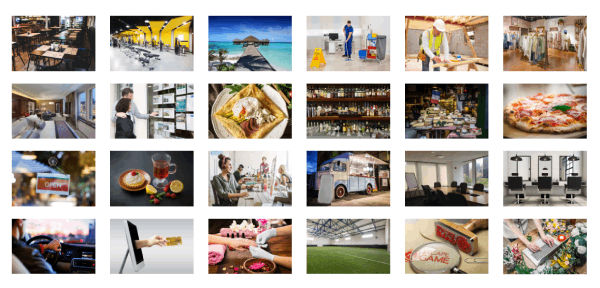
The operating expenses for a hunting lodge
The next step is to estimate the costs you’ll have to incur to operate your hunting lodge.
These will vary based on where your business is located, and its overall size (level of sales, personnel, etc.).
But your hunting lodge's operating expenses should normally include the following items:
- Staff costs: Salaries and wages for your hunting lodge staff, including guides, kitchen staff, and housekeeping.
- Accountancy fees: Fees for an accountant to handle your lodge's financial records and tax preparation.
- Insurance costs: Insurance premiums for your hunting lodge, including liability insurance, property insurance, and workers' compensation insurance.
- Software licenses: Fees for any software licenses needed to run your lodge, such as reservation and booking software.
- Banking fees: Fees for maintaining a business bank account, including monthly maintenance fees and transaction fees.
- Marketing and advertising: Costs for promoting your hunting lodge, such as website development, online ads, and print materials.
- Food and beverage: Expenses for purchasing food and beverages for your lodge's restaurant or dining area.
- Utilities: Costs for electricity, water, and other utilities needed to operate your lodge.
- Maintenance and repairs: Expenses for maintaining and repairing your lodge's facilities and equipment.
- Cleaning supplies: Costs for purchasing cleaning supplies for housekeeping and maintenance staff.
- Office supplies: Expenses for purchasing office supplies, such as paper, pens, and printer ink.
- Transportation: Costs for transportation, such as fuel for vehicles and maintenance costs for a lodge-owned shuttle.
- Training and development: Expenses for training and developing your staff, such as workshops and certifications.
- Permits and licenses: Fees for obtaining necessary permits and licenses for your hunting lodge, such as a hunting license or liquor license.
- Guest amenities: Costs for providing amenities for your guests, such as toiletries, coffee, and snacks.
This list is not exhaustive by any means, and will need to be tailored to your hunting lodge's specific circumstances.
What investments are needed to start or grow a hunting lodge?
Once you have an idea of how much sales you could achieve and what it will cost to run your hunting lodge, it is time to look into the equipment required to launch or expand the activity.
For a hunting lodge, capital expenditures and initial working capital items could include:
- Hunting equipment: This includes items such as rifles, bows, binoculars, and other gear that are necessary for hunting activities at the lodge. It is important to regularly replace and upgrade these items to ensure the safety and satisfaction of your guests.
- Cabin furnishings: Your hunting lodge may have cabins or rooms for guests to stay in. To provide a comfortable and inviting atmosphere, it is important to invest in quality furnishings such as beds, linens, and furniture.
- Property maintenance equipment: As a hunting lodge owner, you are responsible for maintaining the property and ensuring it is safe for guests. This may require purchasing equipment such as lawn mowers, chainsaws, and other tools for regular upkeep and repairs.
- Recreational vehicles: If your hunting lodge offers activities such as ATV tours or fishing trips, you may need to invest in recreational vehicles such as ATVs, boats, and trailers. These can be expensive but are necessary for providing guests with a memorable experience.
- Renovations and upgrades: It is important to regularly update and renovate your hunting lodge to keep it in top condition and attract repeat guests. This may include updating cabins, adding new amenities, or improving the overall appearance of the property.
Again, this list will need to be adjusted according to the specificities of your hunting lodge.
Need a convincing business plan?
The Business Plan Shop makes it easy to create a financial forecast to assess the potential profitability of your projects, and write a business plan that’ll wow investors.
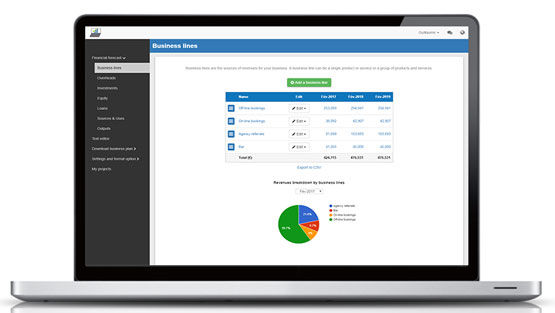
The financing plan of your hunting lodge
The next step in the creation of your financial forecast for your hunting lodge is to think about how you might finance your business.
You will have to assess how much capital will come from shareholders (equity) and how much can be secured through banks.
Bank loans will have to be modelled so that you can separate the interest expenses from the repayments of principal, and include all this data in your forecast.
Issuing share capital and obtaining a bank loan are two of the most common ways that entrepreneurs finance their businesses.
What tables compose the financial plan for a hunting lodge?
Now let's have a look at the main output tables of your hunting lodge's financial forecast.
The forecasted profit & loss statement
The profit & loss forecast gives you a clear picture of your business’ expected growth over the first three to five years, and whether it’s likely to be profitable or not.
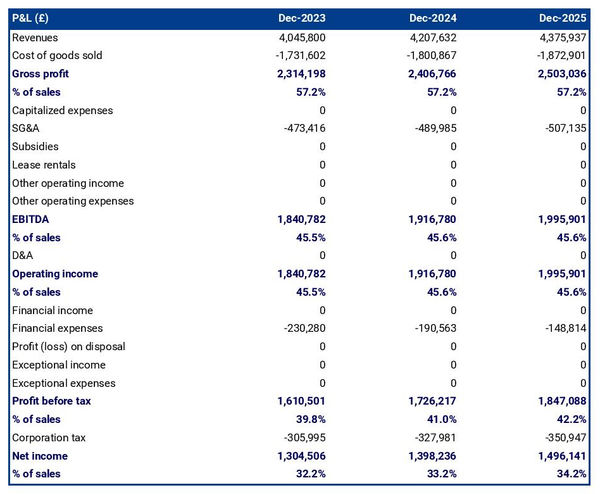
A healthy hunting lodge's P&L statement should show:
- Sales growing at (minimum) or above (better) inflation
- Stable (minimum) or expanding (better) profit margins
- A healthy level of net profitability
This will of course depend on the stage of your business: numbers for an established hunting lodge will look different than for a startup.
The projected balance sheet
The projected balance sheet gives an overview of your hunting lodge's financial structure at the end of the financial year.
It is composed of three categories of items: assets, liabilities and equity:
- Assets: are what the business possesses and uses to produce cash flows. It includes resources such as cash, buildings, equipment, and accounts receivable (money owed by clients).
- Liabilities: are the debts of your hunting lodge. They include accounts payable (money owed to suppliers), taxes due and bank loans.
- Equity: is the combination of what has been invested by the business owners and the cumulative profits to date (which are called retained earnings). Equity is a proxy for the value of the owner's stake in the business.

The cash flow projection
The cash flow forecast of your hunting lodge will show how much cash the business is expected to generate or consume over the next three to five years.

There are multiple ways of presenting a cash flow forecast but from experience, it is better to organise it by nature in order to clearly show these elements:
- Operating cash flow: how much cash is generated by the hunting lodge's operations
- Investing cash flow: what is the business investing to expand or maintain its equipment
- Financing cash flow: is the business raising additional funds or repaying financiers (debt repayment, dividends)
Your cash flow forecast is the most important element of your overall financial projection and that’s where you should focus your attention to ensure that your hunting lodge is adequately funded.
Note: if you are preparing a financial forecast in order to try to secure funding, you will need to include both a yearly and monthly cash flow forecast in your hunting lodge's financial plan.
Need a solid financial forecast?
The Business Plan Shop does the maths for you. Simply enter your revenues, costs and investments. Click save and our online tool builds a three-way forecast for you instantly.

Which tool should you use to create your hunting lodge's financial projections?
Building a hunting lodge financial forecast is not difficult provided that you use the right tool for the job. Let’s see what options are available below.
Using online financial projection software to build your hunting lodge's forecast
The modern and easiest way to build a forecast is to use professional financial projection software such as the one we offer at The Business Plan Shop.
There are several advantages to using specialised software:
- You can easily create your financial forecast by letting the software take care of the financial calculations for you without errors
- You have access to complete financial forecast templates
- You get a complete financial forecast ready to be sent to your bank or investors
- You can easily track your actual financial performance against your financial forecast, and recalibrate your forecast as the year goes by
- You can create scenarios to stress test your forecast's main assumptions
- You can easily update your forecast as time goes by to maintain visibility on future cash flows
- You have a friendly support team on standby to assist you when you are stuck
- It’s cost-efficient and much cheaper than using an accountant or consultant (see below)
If you are interested in this type of solution, you can try our forecasting software for free by signing up here.
Calling in a financial consultant or chartered accountant
Enlisting the help of a consultant or accountant is also a good way to obtain a professional hunting lodge financial forecast.
The downside of this solution is its cost. From experience, obtaining a simple financial forecast over three years (including a balance sheet, income statement, and cash flow statement) is likely to cost a minimum of £700 or $1,000.
The indicative cost above, is for a small business, and a forecast is done as a one-shot exercise. Using a consultant or accountant to track your actuals vs. forecast and to keep your financial projections up to date on a monthly or quarterly basis will cost a lot more.
If you opt for this solution, make sure your accountant has in-depth knowledge of your industry, so that they may challenge your figures and offer insights (as opposed to just taking your assumptions at face value to create the forecast).
Why not use a spreadsheet such as Excel or Google Sheets to build your hunting lodge's financial forecast?
You and your financial partners need numbers you can trust. Unless you have studied finance or accounting, creating a trustworthy and error-free hunting lodge financial forecast on a spreadsheet is likely to prove challenging.
Financial modelling is very technical by nature and requires a solid grasp of accounting principles to be done without errors. This means that using spreadsheet software like Excel or Google Sheets to create accurate financial forecasts is out of reach for most business owners.
Creating forecasts in Excel is also inefficient nowadays:
- Software has advanced to the point where forecasting can be done much faster and more accurately than manually on a spreadsheet.
- With artificial intelligence, the software is capable of detecting mistakes and helping decision-making.
Spreadsheets are versatile tools but they are not tailor-made for reporting. Importing your hunting lodge's accounting data in Excel to track actual vs. forecast is incredibly manual and tedious (and so is keeping forecasts up to date). It is much faster to use dedicated financial planning tools like The Business Plan Shop which are built specially for this.
Need a convincing business plan?
The Business Plan Shop makes it easy to create a financial forecast to assess the potential profitability of your projects, and write a business plan that’ll wow investors.

Use our financial projection templates for inspiration
The Business Plan Shop has dozens of financial forecast templates available.
Our examples contain a complete business plan with a financial forecast and a written presentation of the company, the team, the strategy, and the medium-term objectives.
Whether you are just starting out or already have your own hunting lodge, looking at our financial forecast template is a good way to:
- Understand what a complete business plan should look like
- Understand how you should model financial items for your hunting lodge
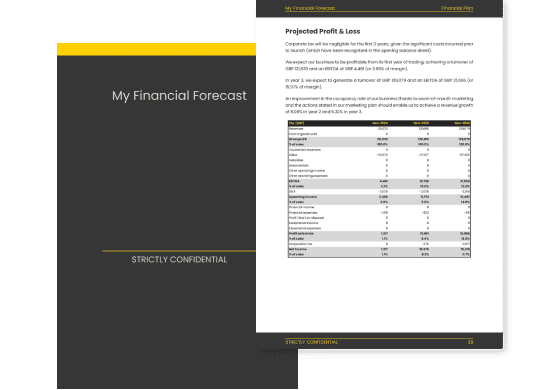
Takeaways
- A financial projection shows expected growth, profitability, and cash generation for your business over the next three to five years.
- Tracking actuals vs. forecast and keeping your financial forecast up-to-date is the only way to maintain visibility on future cash flows.
- Using financial forecasting software makes it easy to create and maintain up-to-date projections for your hunting lodge.
You have reached the end of our guide. We hope you now have a better understanding of how to create a financial forecast for a hunting lodge. Don't hesitate to contact our team if you have any questions or want to share your experience building forecasts!
Need inspiration for your business plan?
The Business Plan Shop has dozens of business plan templates that you can use to get a clear idea of what a complete business plan looks like.

Also on The Business Plan Shop
Know someone who runs or wants to start a hunting lodge? Share our financial projection guide with them!

